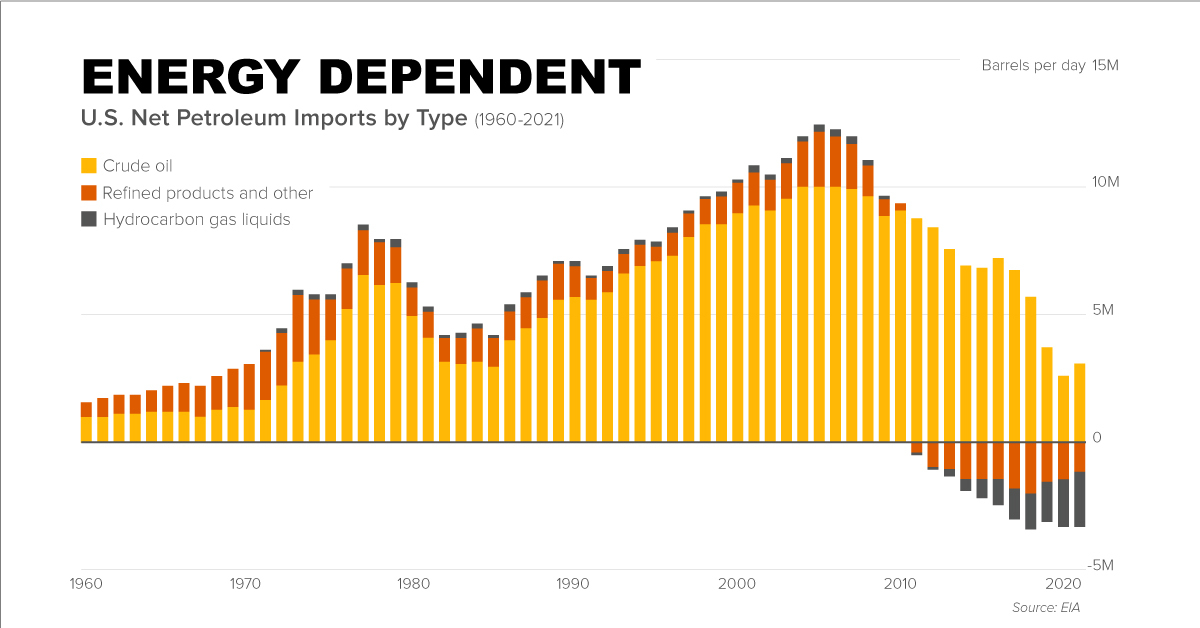The History of U.S. Energy Independence
The History of U.S. Energy Independence
Energy independence has long been a part of America’s political history and foreign policy, especially since the 1970s.
Despite long being a leader in energy production, the U.S. has often still relied on oil imports to meet its growing needs. This “energy dependence” left the country and American consumers vulnerable to supply disruptions and oil price shocks.
The above infographic from Surge Battery Metals traces the history of U.S. energy independence, highlighting key events that shaped the country’s import reliance for oil. This is part one of three infographics in the Energy Independence Series.
How the U.S. Became Energy Dependent
Oil was first commercially drilled in the U.S. in 1859, when Colonel Edwin Drake developed an oil well in Titusville, Pennsylvania.
Twenty years later in 1880, the U.S. was responsible for 85% of global crude oil production and refining. But over the next century, the country became increasingly dependent on oil imports.
Here are some key events that affected America’s oil dependence and foreign policy during that time according to the Council on Foreign Relations:
- 1908: Henry Ford invented the Model T, the world’s first mass-produced and affordable car.
- 1914-1918: The U.S. began importing small quantities of oil from Mexico to meet the demands of World War I and domestic consumption.
- 1942: In efforts to save gas and fuel for World War II, the Office of Defense Transportation implemented a national plan limiting driving speeds to 35 miles per hour.
- 1943: President Roosevelt provided financial support to Saudi Arabia and declared Saudi oil critical to U.S. security.
- 1950: With 40 million cars on the road, the U.S. became a net importer of oil bringing in around 500,000 barrels per day.
- 1970: Twentieth century U.S. oil production peaked and President Nixon eased oil import quotas, allowing an additional 100,000 barrels per day in imports.
The U.S. economy’s increasing reliance on oil imports made it vulnerable to supply disruptions. For example, in 1973, in response to the U.S.’ support for Israel, Arab members of the OPEC imposed an embargo on oil exports to Western nations, creating the first “oil shock”. Oil prices nearly quadrupled, and American consumers felt the shock through long lineups at gas stations along with high inflation. Combined with rising unemployment rates and flattening wages, the increase in prices led to a period of stagflation.
Despite the energy crisis, U.S. oil production fell for decades, while the country met its increasing energy needs with oil from abroad.
The Rise and Fall of U.S. Oil Imports
Here’s how U.S. net imports of crude oil and petroleum products has evolved since 1950 in comparison with consumption and production. All figures are in millions of barrels per day (bpd).
| Year | Consumption (bpd) | Production (bpd) | Net imports (bpd) |
|---|---|---|---|
| 1950 | 6.5M | 5.9M | 0.5M |
| 1960 | 9.8M | 8.1M | 1.6M |
| 1970 | 14.7M | 11.7M | 3.2M |
| 1980 | 17.1M | 10.8M | 6.4M |
| 1990 | 17.0M | 9.6M | 7.2M |
| 2000 | 19.7M | 8.7M | 10.4M |
| 2010 | 19.2M | 9.5M | 9.4M |
| 2021 | 19.8M | 18.7M | -0.2M |
Net oil imports quadrupled between 1960 and 1980, marking the two biggest decadal jumps. Given that production was falling while consumption was booming, it’s clear why the U.S. needed to rely on imports.
Imports peaked in 2005, with net imports accounting for a record 60% of domestic consumption. Both imports and consumption fell in the years that followed. In 2009, for the first time since 1970, U.S. oil production increased thanks to the shale boom. It ascended until 2019 to make the U.S. the world’s largest oil producer.
As of 2021, the U.S. was a net exporter of refined petroleum products and hydrocarbon liquids but remained a net importer of crude oil.
The New Era of Energy
Oil and fossil fuels have long played a central role in the global energy mix. The U.S.’ reliance on other countries for oil made it energy-dependent, exposing American gas consumers to geopolitical shocks and volatile oil prices.
Today, the global energy shift away from fossil fuels towards cleaner sources of generation offers a new opportunity to use lessons from the past. By securing the raw materials needed to enable the energy transition, the U.S. can build a clean energy future independent of foreign sources.
In the next part of the Energy Independence Series sponsored by Surge Battery Metals, we will explore the New Era of Energy and the role of electric vehicles and renewables in the ongoing energy transition.

-

 Sponsored3 years ago
Sponsored3 years agoMore Than Precious: Silver’s Role in the New Energy Era (Part 3 of 3)
Long known as a precious metal, silver in solar and EV technologies will redefine its role and importance to a greener economy.
-

 Sponsored7 years ago
Sponsored7 years agoThe History and Evolution of the Video Games Market
Everything from Pong to the rise of mobile gaming and AR/VR. Learn about the $100 billion video games market in this giant infographic.
-

 Sponsored8 years ago
Sponsored8 years agoThe Extraordinary Raw Materials in an iPhone 6s
Over 700 million iPhones have now been sold, but the iPhone would not exist if it were not for the raw materials that make the technology…
-

 Sponsored8 years ago
Sponsored8 years agoThe Industrial Internet, and How It’s Revolutionizing Mining
The convergence of the global industrial sector with big data and the internet of things, or the Industrial Internet, will revolutionize how mining works.






